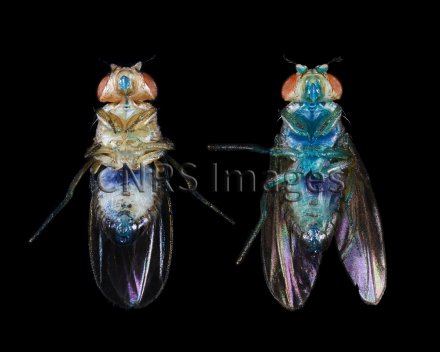Production year
2020

© Michael RERA / Aurore COLIBERT / CRI / B2A / CNRS Images
20220122_0009
In both flies and humans, mortality increases with age. This is one of the possible definitions of “ageing”. However, the nature of this phenomenon, as well as its molecular or evolutionary origins, are still the subject of much debate. Both these female "Drosophila melanogaster" have the same chronological age and genotype. However, the life expectancy of the fly on the right is around three days, as compared to over twenty days for the one on the left. The former has reached the Smurf state, a transition identifiable in vivo by means of a blue dye that crosses the intestinal barrier only in individuals that will soon die. These predictive biomarkers for the occurrence of natural death can be used to study the effects of time and of physiological age separately. Will this type of approach enable us one day to predict our own death? This image is one of the winners of the 2022 La preuve par l’image (LPPI) photography competition.
The use of media visible on the CNRS Images Platform can be granted on request. Any reproduction or representation is forbidden without prior authorization from CNRS Images (except for resources under Creative Commons license).
No modification of an image may be made without the prior consent of CNRS Images.
No use of an image for advertising purposes or distribution to a third party may be made without the prior agreement of CNRS Images.
For more information, please consult our general conditions
2020
Our work is guided by the way scientists question the world around them and we translate their research into images to help people to understand the world better and to awaken their curiosity and wonderment.